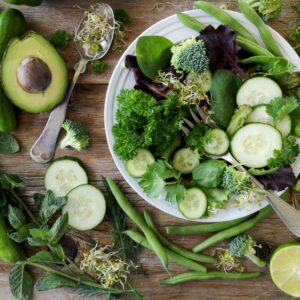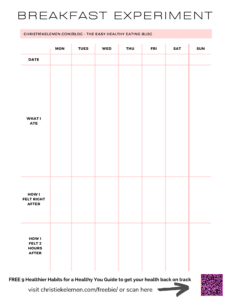I’m hungry, what should I eat?! We all have asked that question when trying to be healthy. The world of constantly changing dietary advice can leave us confused.

Yes, discovering what the healthiest diet is for you can be confusing. But eating well is vital for good health. It helps keep your body strong and energized and gives you the energy to live life to its fullest. This article will provide tips on how to find out how to eat right for you.
What should I eat? – Guidelines
There are many different diets available today. However, you can follow these guidelines when choosing a diet to make the task of choosing the perfect diet easier.
- Choose a diet that works with your bio-individuality.
- Choose a diet that fits into your lifestyle.
- Choose a diet that has been proven to work.
The diet which meets all of these three criteria is the diet that works for you!
What should I eat? – Chose a diet that works with your bio-individuality.

When I attended the Institute for Integrative Nutrition (IIN) to become a Certified Health Coach, one of the first concepts we learned was “bio-individuality.” The school introduced new examples of this every week. At one point, I wanted to say, “Okay, I got it – enough!”. But the constant repetition stresses how important this concept is. You probably have tried many different diets, and each time were disappointed that they did not turn out the way you wished.
Each of us is biologically unique. Our age, health status, childhood, preferences, daily schedule, activity and rest habits, and many more differences make us unique. All of these affects what foods will make up the best diet for us. Don’t look to the person on the television commercial to tell you what to eat. Decide for yourself.
As bio-individuals, we are different in the things that support our health and happiness.
Have you ever noticed one person can thrive on a diet high in protein and fat and extremely low on carbs, but you feel weak and exhausted eating like this? Or have you seen entire families eating bread regularly and maintaining their health, but you seem to gain weight just looking at high-carbohydrate foods? This difference comes from some people’s bodies burning fat for fuel and others burning carbs.
Some people cannot digest dairy because of biological differences. Some can eat only once a day and feel great, while others need to eat the standard three meals per day. And the list goes on. Being healthy involves complex, multidimensional factors. There are many different variables ensuring we aren’t all the same.
IIN states, ” It’s not as simple as maintaining a healthy diet or exercise regimen; it’s understanding that there’s a lot more to it than just making the “right choices.” It’s experimenting to find what the right decisions are for you – the right environment, diet, or workout that helps you thrive right now at this point in your life.” (1)
There are many ways to eat well. You might choose to follow a paleo diet, a vegetarian diet, eat more fish, or avoid processed foods. However, there isn’t one right answer for everyone. Try different approaches until you find what works best for you and your bio-individuality!
What should I eat? – Choose a diet that fits your lifestyle.

It may sound strange to pick a diet based on it fitting into your lifestyle. But it won’t matter how healthy the diet is if you can’t sustain it. Indeed, we all need to make choices and put effort behind them to make them a reality. But if we instill constant, painful stress upon ourselves to meet specific dietary rules, that stress can offset any benefit the diet may provide us. Stress is a huge factor in our health.
See my post on Stress: How to Relieve it to East Your Mind & Body if you struggle with this issue of stress.
Think back on the diets you have tried in the past and note how long each of them lasted. Ask which lasted the longest and why you think that might be. What were the characteristics of that diet that made it doable?
Think critically. You may have ditched a diet high in protein in fat, even though it made you feel fantastic because it required you to spend an unsustainable amount of time preparing food. If that is the case, learning quick cooking methods might be what you need, rather than a different diet.
Check out my cookbook, SHORTCUT REAL FOOD: 20-minute meals cookbook for recipes and ideas for how to cook healthy food faster.
Maybe you loved the packaged diet that provided open and pour food because of its convenience, but you felt bloated and unhealthy. You may want to consider other diets where you felt better but think about how you might make them fit into your lifestyle.
What should I eat? – Choose a diet that has been proven to work.
Learning about available diets is possible by reading books, researching online, or talking with your doctor.
My post, the first in this series, “Do You Know the Healthiest Diet for You?” covers my history of choosing a “lifetime diet” (not an “I need to lose 10 pounds by tomorrow” crazy diet) and what I came to adopt.
Don’t give too much weight to various new fad diets. These diets have little research to back up their claims. And they may end up doing you more harm than good.

Start Listening to Your Body and Find Out Which Foods Work Best for You.
To determine which foods work best for your body, consider your current diet. Do you feel best when you eat mostly lean meats, vegetables, fruits, and whole grains? Or what food is it that makes you feel energetic and stable? Also, look at what brings on sugar crashes or causes bloating or indigestion.
Follow this Breakfast Experiment to help guide you in this exploration.
What should I eat? – BREAKFAST EXPERIMENT
Trying different foods is an excellent way to fine-tune which foods meet your personal needs. And breakfast is a perfect time to experiment, as it sets the tone for the rest of the day. Also, it allows you time to see the results of what you ate as the day progresses.

To start the BREAKFAST EXPERIMENT:
- Choose one of the breakfasts below to eat each morning for one week.
- Spend a few moments quietly reflecting to enable you to listen to what your body is saying.
- Write down what you ate, how you felt right after, and how you felt two hours later.
- If you have two breakfasts, for example, that you think work for you, consider what they have in common. Are they both high in fat? Or are they both very light? Do they contain eggs and/or meat? Or are they vegetarian? Etc.

BREAKFAST 1: Eggs and toast
BREAKFAST 2: Your typical breakfast
BREAKFAST 3: Oatmeal with nuts and fruit
BREAKFAST 4: Fast (Skip Breakfast) – Don’t eat until lunch, or maybe at 9:00 if you are new to fasting.
BREAKFAST 5: Smoothie with coconut milk, protein powder, fruit, and greens
BREAKFAST 6: Fresh Fruit or Vegetables with no other food
BREAKFAST 7: Paleo Hash: bacon, eggs, and low-carb vegetables
I hope this experiment points you in the right direction for discovering your lifetime diet. Read my first post in this series, Do You Know the Healthiest Diet for You? to find out about my lifetime diet.
To guide you in your experiment. I have created this chart to help you keep track throughout the experiment. Click to download a copy.

This blog post is for informational and educational purposes only. It is not intended to treat any health condition or to be prescriptive for anyone. Always be sure to work with your healthcare practitioner before making any changes.
(1) Institute of Integrative Nutrition (www.integrativenutrition.com school for nutrition health coaches)
To subscribe to my weekly email, fill out the form below. You’ll also receive my 9 Healthier Habits for a Healthy You guide when you sign up.






